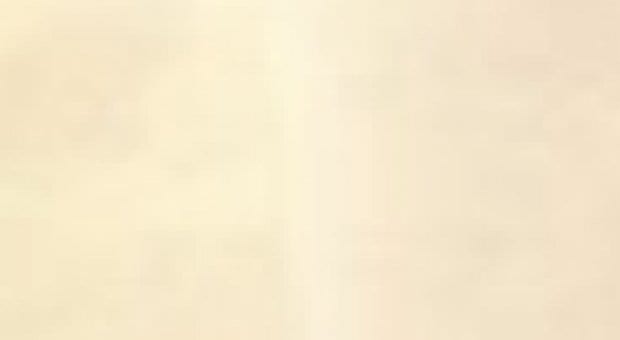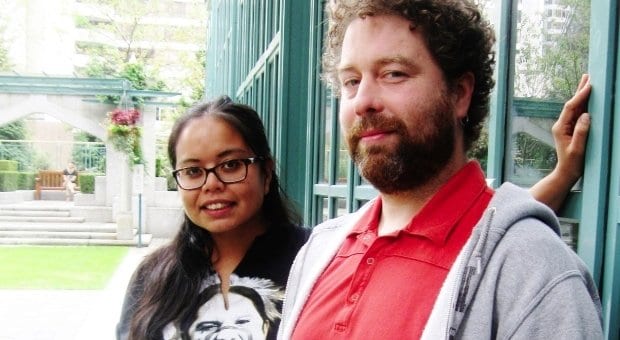
Kwakwaka'wakw/Tlingit artist Corrine Hunt’s piece Gwa'wina + Kwikw. Credit: Shauna Lewis
Declarations of lesbian love on leather and a carefully carved limestone sculpture of male and female genitals are two of the dozens of artworks on display at the RezErect First Nations erotic art exhibition that opened Sept 25 at the Bill Reid Gallery in Vancouver.
Aimed at altering people’s perceptions of First Nations sexuality, the five-month show will highlight the works of 27 indigenous artists who, through their works, have challenged stereotypes and squashed taboos.
“The words say statements like ‘No penis required’ and ‘Lovebirds sloppy and wet,’” says Kwakwaka’wakw/ Tlingit artist Corrine Hunt, translating the candid sexual narratives in her leather, wood and metal piece titled Gwa’wina + Kwikw.
Hunt, who is two-spirited, is well known for her carving, jewellery and mixed-media artworks. She also designed the 2010 Vancouver Winter Olympic medals.
Hunt says she jumped at the opportunity to be a part of RezErect because she wanted to help change society’s perception of First Nations sexuality.
“I think that there’s a conservative idea of what First Nations are like,” she explains. “You have the drunken Indian or you have the hyper-exotic, can-do-no-wrong type person who’s not mischievous and who doesn’t make mistakes.
“I want people to consider that we are healthy in many ways and to show that there is a well-rounded human being in all of this,” she says.
“To see the art as playful is also very important,” she adds, “because it shows another part of who we are as First Nations people.”
Asked if she consciously incorporates two-spirited themes in her work, Hunt pauses.
“Through my work it’s always important if people can somehow get a broader idea of what the art is about, the culture is about and what I’m about as an artist,” she says. “If the two-spirited comes into that, then that’s great. That’s who I am.
“I try to be as open as I can with all aspects of my life — with politics, religion and my sexuality,” she continues, “and I hope that people can feel that it’s okay to be who they are.”
Two-spirited references in indigenous art have “been part of our consciousness,” says Haida artist and co-curator Gwaai Edenshaw, even if it’s not blatantly apparent in some of the art in the exhibit, he adds.
“It’s been an element that we’ve considered during the entire [exhibit planning] process, but we haven’t segregated it specifically because we don’t see it as a separate thing to First Nations sexuality,” artist and co-curator Kwiaahwah Jones explains.
“We’ve included artists that might blur the lines of what is considered conventional,” Jones says.
“Among the artists, everyone is pretty holistic on their views of sexuality,” she says.
“The name of the game for the show is diversity,” she says. “I don’t feel that the line defining two-spirited is the norm in our [First Nation] community.”
“Erotica has been in First Nations art all along, so it’s not particularly contemporary,” Edenshaw notes. “We’re putting a focus on it in this show, but we’re not doing anything new.”
Mainstream media representations of native sexuality too often focus on stories of abuse, he says.
“It’s within this context of dysfunction, and it’s always sort of a painful story that we hear associated with it, and that’s our experience,” he says. “But it’s not the whole of our experience.
“Native people have full sexual lives outside of all that hard stuff,” he says. “I think it’s good to reinforce those messages.”
Edenshaw, who trained under master Northwest Coast artist Bill Reid, has submitted five works of art to the show.
His pieces examine aspects of voyeurism, nudity, group sex and sexual positions through sculptures carved out of fishing floats, paintings and other mixed media.
For Edenshaw, as for many First Nations artists, sensuality can be found in the subtle places.
“The message is that there is already sensuality in the form line, and you don’t need fat cocks or boobs or anything like that,” he says.
Still, cock and labia are front-and-centre in Tlingit carver Robin Lovelace’s exhibition piece, fittingly titled Tool.
Depicting both a vulva and penis within the constructs of a sexually stylized limestone carving tool, the piece emphasizes the balance between technical and visceral creativity, Lovelace says.
It also denotes the need for social and sexual balance between the sexes, she says. “The reality is, is that when you don’t accept and celebrate the equality of the sexes it deems one sex below the other.”
Lovelace says Tool is about a marriage of masculine and feminine energy that can apply to all genders, cultures and sexual orientations.
“To me, this work is not so much about the package. It’s about the energy. It transcends form.”
It’s about the varying degrees of masculine and feminine energy within all of us, she says.
Other pieces in the exhibit include handcrafted seaweed panties, a stone-sculpted penis, a beaver-fur-clad bentwood box lined in pink paint, and a tightly woven wool weaving depicting a vagina.
Interactive lectures, roundtable discussions and a feast are also planned for the exhibit.
RezErect runs until Feb 16 and is funded by the City of Vancouver, the British Columbia Arts Council, the First Peoples’ Cultural Council and various private donors.
RezErect
Runs until Feb 16
Bill Reid Gallery, 639 Hornby St
billreidgallery.ca

 Why you can trust Xtra
Why you can trust Xtra


